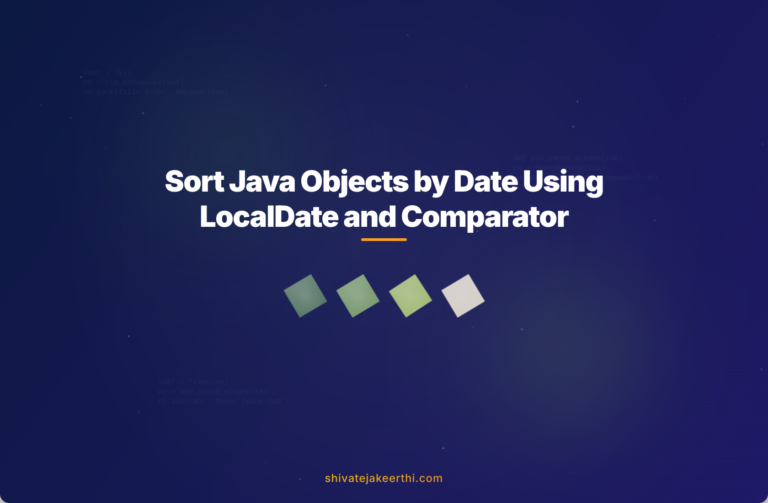Working with collections of objects in Java often means you’ll encounter scenarios where sorting becomes vital. Imagine you have a list of products, each having a date of production and other descriptive fields. Sorting these objects efficiently could seem straightforward until you run into date strings formatted as text. Furthermore, when two products have the same date, a secondary sorting criterion like country or product description becomes necessary.
In many real-world Java applications, this sorting scenario is common—think of organizing inventory software data, e-commerce product listings, or analyzing production logs. Ensuring that objects in your collection are sorted correctly by both the production date and a secondary parameter is a practical necessity rather than just an optional improvement.
So, how exactly can you handle sorting these objects correctly? Let’s first clarify what our objects look like.
Understanding the Product Class in Java
Consider a basic class called Product. Each product might have attributes such as productionDate, productionCountry, and productDescription. Typically, developers represent the productionDate field as a String for readability, such as “2024-03-25”. Here’s an example:
public class Product {
private String productionDate;
private String productionCountry;
private String productDescription;
public Product(String productionDate, String productionCountry, String productDescription) {
this.productionDate = productionDate;
this.productionCountry = productionCountry;
this.productDescription = productDescription;
}
public String getProductionDate() {
return productionDate;
}
public String getProductionCountry() {
return productionCountry;
}
public String getProductDescription() {
return productDescription;
}
}
Your list may look something like this:
List<Product> products = Arrays.asList(
new Product("2024-03-20", "Germany", "Electric Drill"),
new Product("2023-12-12", "USA", "Hammer"),
new Product("2024-03-20", "China", "Cordless Screwdriver"),
new Product("2024-01-01", "Germany", "Saw")
);
Importance of sorting collections in Java
In programming, sorting is important as it helps us structure data clearly and logically. Java provides several built-in tools to make sorting easier. Among these are methods like Comparators, implementing the Comparable interface, and streams introduced with Java 8.
Comparators are flexible as they allow sorting on multiple attributes. Let’s first look at a straightforward approach using a Comparator based on the String date field:
products.sort(Comparator.comparing(Product::getProductionDate));
Though the code looks fine, sorting by string-type dates can lead to inaccuracies and issues.
Why Isn’t Sorting by String Dates a Good Idea?
Sorting by the string representation of dates can give incorrect results. String sorting compares character by character, which works for dates only if they are strictly in the “YYYY-MM-DD” format. Even tiny format variations could break your sorting. Moreover, if you someday change the date format, the order will become inconsistent.
To get solid and reliable sorting, converting these strings to Java’s Date type is the way to go.
Converting String to Date Type in Java
A better approach involves parsing the date string into the Date or modern LocalDate type. Here’s a brief example of converting your productionDate String to Java’s LocalDate type (recommended):
import java.time.LocalDate;
import java.time.format.DateTimeFormatter;
// Within the Product class, add a method for getting parsed date
public LocalDate getParsedProductionDate() {
return LocalDate.parse(productionDate, DateTimeFormatter.ISO_DATE);
}
Now your dates can be handled precisely, enabling accurate sorting calculations using real date values.
Sorting Products by Date Type in Java
Once you have local date values, sorting becomes simple and reliable:
products.sort(Comparator.comparing(Product::getParsedProductionDate));
This approach ensures your list is consistently ordered by actual dates and not textual representations. To understand better how Java Comparator works, check out this detailed explanation on Stack Overflow.
Sorting by Multiple Fields
Oftentimes, two or more products might share the same production date. In these cases, a secondary criterion—such as country or product description—is handy. Java makes sorting with multiple fields relatively simple by chaining comparators using thenComparing():
Here’s how you can sort your products first by date, then by country:
products.sort(
Comparator.comparing(Product::getParsedProductionDate)
.thenComparing(Product::getProductionCountry)
);
You can even add more criteria easily:
products.sort(
Comparator.comparing(Product::getParsedProductionDate)
.thenComparing(Product::getProductionCountry)
.thenComparing(Product::getProductDescription)
);
With this method, the sorting logic remains clean, readable, and extremely maintainable.
Applying the Solution to Your Situation
Let’s briefly revisit the initial problem. Initially, sorting directly by the String field for your dates caused subtle bugs and inconsistencies. This becomes clear from the real-world scenario: imagine two products manufactured on the same date but displayed incorrectly due to localization or string format variations.
By converting these String dates into Java’s LocalDate type, you eliminate ambiguity and ensure consistency. Combine that with secondary sorting fields (like country), and your objects will always display logically and reliably.
Here’s the complete working solution applied to your original example:
import java.time.LocalDate;
import java.time.format.DateTimeFormatter;
import java.util.Arrays;
import java.util.Comparator;
import java.util.List;
public class ProductExample {
public static void main(String[] args) {
List<Product> products = Arrays.asList(
new Product("2024-03-20", "Germany", "Electric Drill"),
new Product("2023-12-12", "USA", "Hammer"),
new Product("2024-03-20", "China", "Cordless Screwdriver"),
new Product("2024-01-01", "Germany", "Saw")
);
products.sort(
Comparator.comparing(Product::getParsedProductionDate)
.thenComparing(Product::getProductionCountry)
);
products.forEach(p -> System.out.println(p.getProductionDate() + " | "
+ p.getProductionCountry() + " | "
+ p.getProductDescription()));
}
}
This solution neatly sorts products first by actual date, then by production country clearly and correctly.
Remember, to extend your skills further, you might wish to consider exploring similar JavaScript scenarios and comparisons by checking out this helpful collection of JavaScript articles which highlight sorting techniques in JavaScript contexts.
Sorting your objects correctly isn’t just about better visuals—it’s crucial for functionality, readability, and accurate data presentation in real-world Java applications.
Having tried this yourself, did you find certain challenges in your implementation? Are there additional sorting criteria you typically apply in your projects? We’d love to hear your insights—please feel free to share below!



0 Comments